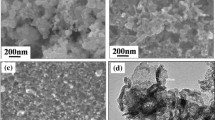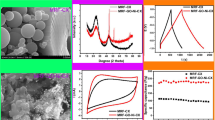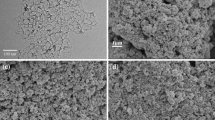Abstract
Phosphorous-enriched nanoporous carbon materials gained much interest as electrodes used in the electrical double layer capacitors due to their large and prolonged electrochemical energy storage. In this work, two carbon xerogels (CX and CX-P) prepared from resorcinol–formaldehyde before and after chemical treatment with phosphoric acid were studied as electrode materials. Phosphoric acid treatment efficiently produced the phosphorous functional groups in the framework of carbon xerogel, enhancing the electrochemical capacitance. Samples were characterized by means of field emission scanning electron microscopy, nitrogen adsorption at −196 °C, fourier transform infrared spectroscopy and X-ray photoelectron spectroscopy. The electrochemical behaviors were demonstrated by cyclic voltammetry, galvanostatic charge–discharge and electrochemical impedance spectroscopy. Although low significant changes in the morphology and porosity were made on CX-P xerogel, a remarkable abundant in the phosphorous-containing oxygen functional groups was developed with the chemical treatment. Efficiently produced phosphorous functional groups in the carbon xerogel framework enhanced the electrochemical capacitance to large extent. Capacitance value was increased 4.8 times from 38 F/g for CX electrode to 183 F/g for CX-P electrode at 5 mV/s. Moreover, CX-P preserved about 79% of capacitance on 200 mV/s scan rate. CX-P electrode exhibited identical triangular type charge-discharge curves throughout the increases in the current densities from 1 to 20 A/g, very promising for electrochemical capacitor applications.
Graphical Abstract







Similar content being viewed by others
References
Simon P, Gogotsi Y (2008) Materials for electrochemical capacitors. Nat Mater 7(11):845–854
Zhang LL, Zhao XS (2009) Carbon-based materials as supercapacitor electrodes. Chem Soc Rev 38(9):2520–2531
Frackowiak E, Béguin F (2001) Carbon materials for the electrochemical storage of energy in capacitors. Carbon 39(6):937–950
Fischer U, Saliger R, Bock V, Petricevic R, Fricke J (1997) Carbon aerogels as electrode material in supercapacitors. J Porous Mater 4(4):281–285
Wang G, Zhang L, Zhang J (2012) A review of electrode materials for electrochemical supercapacitors. Chem Soc Rev 41(2):797–828
Halama A, Szubzda B, Pasciak G (2010) Carbon aerogels as electrode material for electrical double layer supercapacitors—Synthesis and properties. Electrochim Acta 55(25):7501–7505
Frackowiak E (2007) Carbon materials for supercapacitor application. PCCP 9(15):1774–1785
Tao Y, Endo M, Ohsawa R, Kanoh H, Kaneko K (2008) High capacitance carbon-based xerogel film produced without critical drying. Appl Phys Lett 93(19):193112
Chmiola J, Yushin G, Gogotsi Y, Portet C, Simon P, Taberna PL (2006) Anomalous increase in carbon capacitance at pore sizes less than 1 nanometer. Science 313(5794):1760–1763
Portet C, Taberna PL, Simon P, Flahaut E (2005) Influence of carbon nanotubes addition on carbon–carbon supercapacitor performances in organic electrolyte. J Power Sources 139(1–2):371–378
Lu Y, Chen Y (2015) Graphene and porous nanocarbon materials for supercapacitor applications. nanocarbons for advanced energy storage. Wiley-VCH Verlag GmbH & Co. KGaA, Germany, pp 301–338
Pandolfo AG, Hollenkamp AF (2006) Carbon properties and their role in supercapacitors. J Power Sources 157(1):11–27
Largeot C, Portet C, Chmiola J, Taberna P-L, Gogotsi Y, Simon P (2008) Relation between the ion size and pore size for an electric double-layer capacitor. J Am Chem Soc 130(9):2730–2731
Iijima S (1991) Helical microtubules of graphitic carbon. Nature 354(6348):56–58
Portet C, Yushin G, Gogotsi Y (2007) Electrochemical performance of carbon onions, nanodiamonds, carbon black and multiwalled nanotubes in electrical double layer capacitors. Carbon 45(13):2511–2518
Bordjiba T, Mohamedi M, Dao LH (2008) Charge storage mechanism of binderless nanocomposite electrodes formed by dispersion of CNTs and carbon aerogels. J Electrochem Soc 155(2):A115–A124
Wu X-L, Xu A-W (2014) Carbonaceous hydrogels and aerogels for supercapacitors. J Mater Chem A 2(14):4852–4864
Jiang H, Lee PS, Li C (2013) 3D carbon based nanostructures for advanced supercapacitors. Energy Environ Sci 6(1):41–53
Worsley MA, Satcher JH, Baumann TF (2008) Synthesis and characterization of monolithic carbon aerogel nanocomposites containing double-walled carbon nanotubes. Langmuir 24(17):9763–9766
Hulicova-Jurcakova D, Seredych M, Lu GQ, Bandosz TJ (2009) Combined effect of nitrogen- and oxygen-containing functional groups of microporous activated carbon on its electrochemical performance in supercapacitors. Adv Funct Mater 19(3):438–447
Hasegawa G, Deguchi T, Kanamori K, Kobayashi Y, Kageyama H, Abe T, Nakanishi K (2015) High-level doping of nitrogen, phosphorus, and sulfur into activated carbon monoliths and their electrochemical capacitances. Chem Mater 27(13):4703–4712
Jeong HM, Lee JW, Shin WH, Choi YJ, Shin HJ, Kang JK, Choi JW (2011) Nitrogen-doped graphene for high-performance ultracapacitors and the importance of nitrogen-doped sites at basal planes. Nano Lett 11(6):2472–2477
Fathy NA, Attia AA, Hegazi B (2016) Nanostructured activated carbon xerogels for removal of methomyl pesticide. Desalination Water Treat 57(21):9957–9970
Paraknowitsch JP, Thomas A (2013) Doping carbons beyond nitrogen: an overview of advanced heteroatom doped carbons with boron, sulphur and phosphorus for energy applications. Energy Environ Sci 6(10):2839–2855
Wickramaratne NP, Xu J, Wang M, Zhu L, Dai L, Jaroniec M (2014) Nitrogen enriched porous carbon spheres: attractive materials for supercapacitor electrodes and CO2 adsorption. Chem Mater 26(9):2820–2828
Wei J, Zhou D, Sun Z, Deng Y, Xia Y, Zhao D (2013) A controllable synthesis of rich nitrogen-doped ordered mesoporous carbon for CO2 capture and supercapacitors. Adv Funct Mater 23(18):2322–2328
Li B, Dai F, Xiao Q, Yang L, Shen J, Zhang C, Cai M (2016) Nitrogen-doped activated carbon for a high energy hybrid supercapacitor. Energy Environ Sci 9(1):102–106
Wang D-W, Li F, Chen Z-G, Lu GQ, Cheng H-M (2008) Synthesis and electrochemical property of boron-doped mesoporous carbon in supercapacitor. Chem Mater 20(22):7195–7200
Chen L-F, Huang Z-H, Liang H-W, Gao H-L, Yu S-H (2014) Three-dimensional heteroatom-doped carbon nanofiber networks derived from bacterial cellulose for supercapacitors. Adv Funct Mater 24(32):5104–5111
Yan X, Yu Y, Ryu S-K, Lan J, Jia X, Yang X (2014) Simple and scalable synthesis of phosphorus and nitrogen enriched porous carbons with high volumetric capacitance. Electrochim Acta 136:466–472
Fathy NA, Annamalai KP, Tao Y (2017) Effects of phosphoric acid activation on the nanopore structures of carbon xerogel/carbon nanotubes hybrids and their capacitance storage. Adsorption 23:355–360
Wu X, Radovic LR (2006) Inhibition of catalytic oxidation of carbon/carbon composites by phosphorus. Carbon 44(1):141–151
Fathy NA, Shouman MA, Aboelenin RMM (2016) Nitrogen and phosphorous-doped porous carbon xerogels as metal-free catalysts for environmental catalytic peroxide oxidation of 4-nitrophenol. Asia Pac J Chem Eng 11(6):836–845
Puziy AM, Poddubnaya OI, Martı́nez-Alonso A, Suárez-Garcı́a F, JMD Tascón (2002) Synthetic carbons activated with phosphoric acid: I. Surface chemistry and ion binding properties. Carbon 40(9):1493–1505
Annamalai KP, Gao J, Liu L, Mei J, Lau W, Tao Y (2015) Nanoporous graphene/single wall carbon nanohorn heterostructures with enhanced capacitance. J Mater Chem A 3(22):11740–11744
Li C, Wang D, Liang T, Wang X, Ji L (2004) A study of activated carbon nanotubes as double-layer capacitors electrode materials. Mater Lett 58(29):3774–3777
Z-h Hou, X-h Li, Z-q He, E-h Liu, L-f Deng (2004) Influence of polyethylene glycol on pore structure and electric double-layer capacitance of carbon xerogel. J Cent South Univ Technol 11(3):255–260
Fang B, Binder L (2006) A modified activated carbon aerogel for high-energy storage in electric double layer capacitors. J Power Sources 163(1):616–622
Hao G-p MiJ, Li D, Qu W-h, Wu T-j, Li W-c, Lu A-h (2011) A comparative study of nitrogen-doped hierarchical porous carbon monoliths as electrodes for supercapacitors. New Carbon Mater 26(3):197–203
Zera E, Nickel W, Hao GP, Vanzetti L, Kaskel S, Soraru GD (2016) Nitrogen doped carbide derived carbon aerogels by chlorine etching of a SiCN aerogel. J Mater Chem A 4(12):4525–4533
Hsieh C-T, Teng H (2002) Influence of oxygen treatment on electric double-layer capacitance of activated carbon fabrics. Carbon 40(5):667–674
Acknowledgements
This work was supported by the National Natural Science Foundation of China (21273236), the Science and Technology Planning Projects of Fujian Province of China (2014H2008, 2015I0008 and 2014H4006), R&D Projects of Fujian Development and Reform Commission, and STS Project of Fujian-CAS (2016T3036). N. A. F. and K. P. A acknowledge the post-doctoral research programs.
Author information
Authors and Affiliations
Corresponding authors
Ethics declarations
Conflict of interest
The authors declare that they have no competing interests.
Rights and permissions
About this article
Cite this article
Annamalai, K.P., Fathy, N.A. & Tao, Y. Synthesis and capacitance performance of phosphorous-enriched carbon xerogel. J Sol-Gel Sci Technol 84, 515–521 (2017). https://doi.org/10.1007/s10971-017-4452-6
Received:
Accepted:
Published:
Issue Date:
DOI: https://doi.org/10.1007/s10971-017-4452-6




